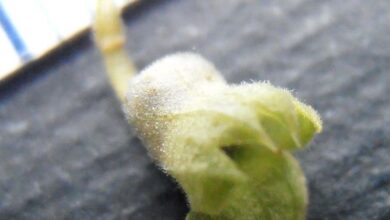Horsetail (Equisetum arvense)

The Equisetum arvense is one of the species known under the name ponytail. It is a very fast growing plant, perfect for growing in ponds and even in pots without holes, since its height is rather low.
Although it does not produce ornamental flowers, its bearing and the shape of its leaves make it a very interesting idea to have it around. In addition, it is so easy to take care of that it is probably hard to believe it .
Origin and characteristics

Image – Wikimedia/ Zeynel Cebeci
Our protagonist is a plant native to the east coast of the Spanish coast, except in the Valencian Community, and also from the island of Mallorca, in the Balearic archipelago. It is popularly known as horsetail, horsetail, rattail, silver cleaner, one hundred knuckles or candalilo. It grows as a rhizomatous perennial shrub near freshwater streams, reaching a maximum height of 50 centimeters.
Its stems are thin, and can be sterile or fertile, the latter being shorter and somewhat more succulent than the former. The leaves are linear, green in color. And it blooms in spring.
What is the care for Equisetum arvense ?

Image – Wikimedia/ MPF
Do you want to know how this beautiful plant is cared for? Take note:
Location
You have to have it outside, in full sun. In semi-shadow it has a poorer development.
It could also be enjoyed at home, as long as it is in a very bright room such as an interior patio for example, but it is not ideal.
Earth
It depends on where you have it:
- Pot: use universal growing medium (on sale here ), but first put a layer of clay (on sale here ) or volcanic clay (on sale here ).
- Garden: grows in calcareous, well-drained soils.
Irrigation
Very common. Being semi-aquatic, the soil or substrate must always be wet. If you have it in a pot, you can put a plate -or a pot without holes- and fill it, or plant it directly in a bucket of those rubber that gardeners use a lot, of this type:
I can tell you that I have a papyrus ( Cyperus papyrus ) in a bucket of those and it grows luxurious, so the Equisetum arvense, having very similar needs, I am convinced that it will also make you beautiful.
Subscriber

As important as water is the fertilizer. No plant can live only with its thirst quenched. But beware, you should not use just any fertilizer, since having medicinal properties it is possible that, sooner or later, you want to take advantage of its benefits. Organic fertilizers are the best in these cases, since they do not pose any danger to humans.
For this reason, we advise you to use, for example, guano ( here you have it in powder and here liquid), compost, mulch, egg and banana shells, etc.
Planting or transplanting time
In spring, when the risk of frost has passed and the minimum temperature remains above 10-15 degrees Celsius.
Multiplication
The Equisetum arvense multiplies by division of the rhizomes in spring. To do this, you have to dig up its roots a little and with a previously disinfected knife cut a piece, which will be planted in a pot or elsewhere in the garden.
Plagues and diseases
It has no reason to make it so easy to maintain .
Rusticity
It resists frosts down to -12ºC. If you live in a colder area, protect it in a greenhouse or indoors.

Related article:Types of greenhouses: which one do I choose?
What uses does it have?
Ornamental
It is a very decorative plant, perfect to have in pots, ponds, or in the garden if it receives plenty of water. It is the right size to be used as a border or delimiting plant, but also to stand out on a balcony, patio or terrace.
Medicinal

Horsetail has diuretic, healing and topical properties, which means that it increases the elimination of urine, helps close -surface- wounds, and has also been used to relieve the symptoms of arthritis, osteoarthritis, tuberculosis and renal problems.
In order to benefit from it, you must use the stems and leaves in infusion, although today they sell creams, pills and even smoothies.
Important: you may have read or read somewhere that can also be used for stones, be they kidney or biliary. But you have to know that no treatment should be started without first consulting with a doctor. You don’t play with health (or you shouldn’t play). He thinks that for example calculations, that is, stones, are a very serious matter.
It is enough to take something so that, yes, they break, but once broken they go through conduits that they should not. If that happens, you would have a much bigger problem (for example, in the case of gallstones, one of those could go into the pancreas and cause pancreatitis).
With this in mind, we only recommend its use for minor problems.
What do you think of Equisetum arvense ?




